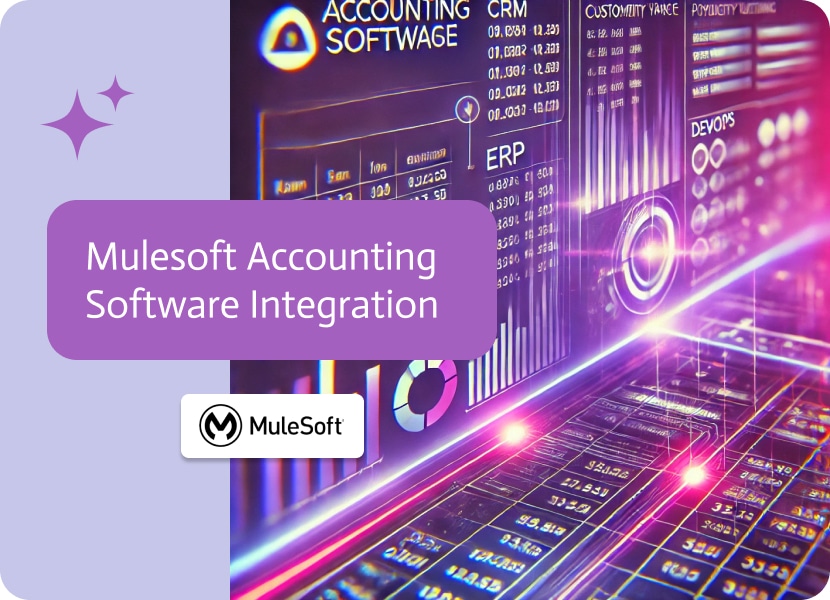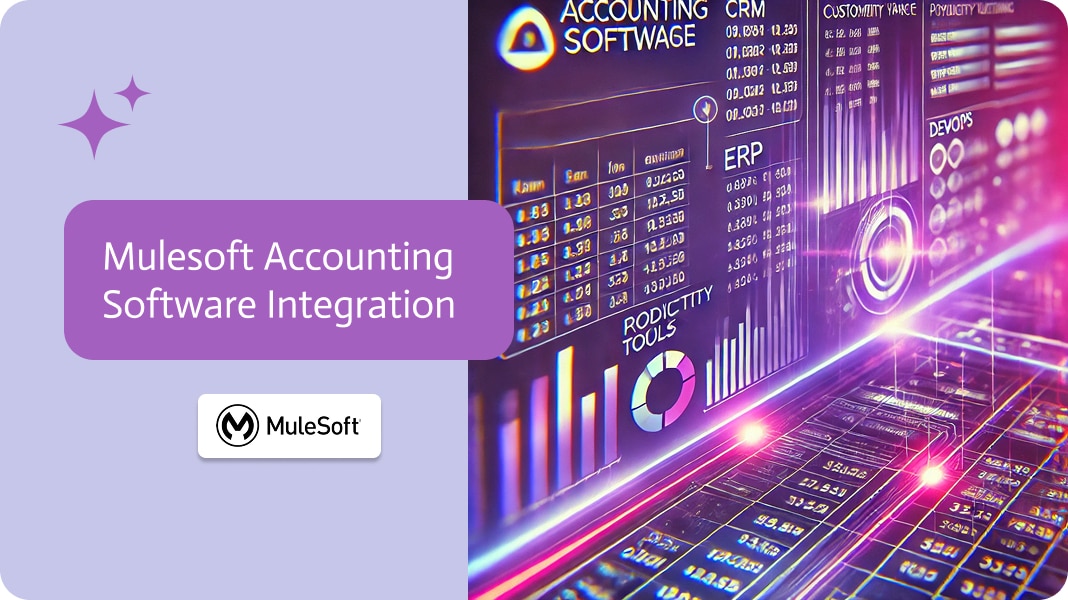

Mulesoft Accounting Software Integration
Introduction to Mulesoft for Accounting Software Integration
Mulesoft, a premier integration platform as a service (iPaaS), enables seamless connections between various applications and systems. It bridges cloud-based and on-premises applications, facilitating smooth data exchange and process automation. The Mulesoft Anypoint Platform is particularly effective for integrating accounting software, significantly reducing manual tasks and errors. By use Mulesoft accounting software integrations, you enhance data consistency and improve financial management, making it a vital tool for optimizing accounting operations.
The Importance of Accounting Software Integration
Accounting software integration is essential for creating a cohesive and efficient financial management system within an organization. By integrating various business applications and data sources, accounting software integration ensures that financial data is centralized, accurate, and up-to-date. This integration improves communication between departments, automates routine financial tasks, and enhances overall operational efficiency. The result is a streamlined financial process that supports better decision-making and strategic planning.
Top Use Cases for Mulesoft Accounting Software Integration
1. Salesforce and QuickBooks Software Integration
Use Case: Integrating Salesforce with QuickBooks enhances financial and customer relationship management. This integration ensures that all sales and financial data are synchronized across platforms, providing a unified view of customer transactions and financial status.
Real-Life Example: A retail company uses Salesforce for managing customer interactions and QuickBooks for accounting. The software integration with the Mulesoft Anypoint Platform, every sale recorded in Salesforce is automatically updated in QuickBooks. This automation eliminates manual data entry, reduces errors, and ensures accurate financial records.
Benefits software integration:
- Unified financial and customer data
- Automated data syncing
- Improved workflow efficiency
- Enhanced team collaboration
2. Workday and Xero Integration
Use Case: Syncing Workday with Xero streamlines financial and human resources processes. This integration ensures that payroll, expenses, and financial data are accurately captured and reflected across systems, enhancing overall financial management.
Real-Life Example: A tech startup uses Workday for HR and payroll management and Xero for accounting. Integrating these tools with the Mulesoft Anypoint Platform allows payroll data to be automatically recorded in Xero whenever salaries are processed in Workday. This ensures financial records are always current and accurate.
Benefits of software integration:
- Unified HR and financial data
- Automated payroll and expense reporting
- Improved financial oversight
- Enhanced operational efficiency
3. NetSuite and Concur Integration
Use Case: Integrating NetSuite with Concur automates travel and expense management workflows. This ensures that all travel expenses are captured and reflected in NetSuite, aiding in better financial control and compliance.
Real-Life Example: A multinational corporation uses NetSuite for ERP and Concur for managing travel expenses. By integrating these systems through the Mulesoft Anypoint Platform, travel expenses recorded in Concur are automatically updated in NetSuite. This integration streamlines expense reporting and improves financial accuracy.
Benefits of accounting software integration:
- Unified travel expense management
- Automated expense reporting
- Improved financial control
- Enhanced compliance
4. Sage Intacct and Trello Integration
Use Case: Connecting Sage Intacct with Trello automates project-based financial tracking. This integration ensures that project expenses and budgets are accurately tracked and reflected in Sage Intacct, enhancing project financial management.
Real-Life Example: A marketing agency uses Sage Intacct for accounting and Trello for project management. By integrating these tools with the Mulesoft Anypoint Platform, project-related expenses logged in Trello are automatically updated in Sage Intacct. This ensures accurate budget tracking and financial reporting for each project.
Benefits of accounting software integration:
- Automated project expense tracking
- Centralized project financial data
- Improved budget management
- Enhanced project financial reporting
5. Zoho Books and Shopify Integration
Use Case: Syncing Zoho Books with Shopify streamlines e-commerce financial management. This integration ensures that sales and payment data are accurately captured and reflected in Zoho Books, simplifying financial tracking and reconciliation.
Real-Life Example: An online store uses Zoho Books for accounting and Shopify for e-commerce. By integrating these platforms with the Mulesoft Anypoint Platform, sales transactions from Shopify are automatically recorded in Zoho Books. This integration ensures accurate financial records and simplifies reconciliation processes.
Benefits:
- Accurate sales tracking
- Automated financial updates
- Improved reconciliation
- Enhanced financial reporting
6. FreshBooks and Trello Integration
Use Case: Integrating FreshBooks with Trello ensures seamless financial data sharing and project expense management. This integration allows teams to access, share, and update financial data in real-time, improving data management and collaborative efforts.
Real-Life Example: A design firm uses FreshBooks for invoicing and Trello for project management. By integrating these tools via the Mulesoft Anypoint Platform, invoicing data from FreshBooks is automatically updated in Trello. This facilitates real-time expense tracking and financial reporting for ongoing projects.
Benefits:
- Centralized financial data
- Automated project expense updates
- Enhanced collaboration
- Improved financial tracking
Key Benefits of Using Mulesoft for Accounting Software Integration
- Automation of Financial Processes: The Mulesoft Anypoint Platform automates repetitive financial tasks, reducing manual effort and minimizing errors. This allows finance teams to focus on strategic initiatives that drive business growth.
- Enhanced Financial Control and Oversight: Integrating various financial tools and platforms with Mulesoft consolidates operations, reduces silos, and promotes collaboration across departments, leading to higher productivity and efficiency.
- Advanced Financial Analytics and Reporting: Unified financial data from multiple sources allows for advanced analytics and reporting, providing valuable insights into business performance and financial trends to inform strategic growth.
- Improved Compliance and Risk Management: Automation and integration ensure that financial processes comply with regulations and standards, reducing the risk of errors and enhancing overall financial governance.
- Real-Time Data Synchronization: Ensuring that information is consistent and up-to-date across all systems facilitates accurate reporting and effective decision-making.
Challenges of Mulesoft for Accounting Software Integration
- Complexity of Financial Workflows: Integrating accounting software with other business applications can be complex due to the specific financial workflows and regulatory requirements involved. The extensive features of the Mulesoft Anypoint Platform, while powerful, can add to this complexity. Users without advanced technical skills may find it challenging to set up and manage these integrations effectively, requiring significant IT involvement.
- Data Accuracy and Reconciliation Issues: Accurate data transfer is crucial in accounting to ensure proper financial reporting and compliance. Users have reported issues with Mulesoft’s data synchronization, leading to discrepancies that require manual reconciliation. This can be time-consuming and prone to errors, affecting the reliability of financial data and requiring IT support to resolve.
- Compatibility with Legacy Systems: Many accounting departments still rely on legacy systems that may not be fully compatible with modern integration platforms like Mulesoft. Integrating these older systems can be difficult, often requiring custom development and additional IT resources to bridge compatibility gaps, which can be costly and time-consuming.
- Customization Limitations: While Mulesoft offers a variety of pre-built connectors and templates, there may be limitations in customizing workflows specific to accounting needs. Businesses with unique or highly specialized financial processes might find these limitations restrictive, necessitating additional manual work or custom development.
- Compliance and Security: Accounting software handles sensitive financial information that must comply with various regulatory standards (e.g., GAAP, IFRS). Ensuring Mulesoft meets all necessary security and compliance requirements can be challenging. Users must implement stringent access controls and monitoring to protect financial data, often requiring IT expertise.
- Learning Curve for Business Users: Despite being marketed as a user-friendly platform, Mulesoft still requires a significant investment in training and learning. Accounting teams, typically composed of business users rather than IT professionals, may find it difficult to fully utilize all features without extensive training, which can delay implementation and reduce the platform’s effectiveness.
- High Costs: Mulesoft’s pricing structure can be a significant obstacle, particularly for smaller businesses or startups. The costs escalate rapidly with the addition of more integrations, users, and features. This high price point can make Mulesoft less accessible for organizations with limited budgets, forcing them to seek alternative solutions or reduce the scope of their integrations.
- Lack of AI Capabilities: One of the significant drawbacks of Mulesoft is the lack of advanced AI capabilities. Intelligent automation and AI-driven features are increasingly important for enhancing the efficiency and effectiveness of accounting software integration. The absence of robust AI functionality in Mulesoft means that many complex tasks still require manual intervention, reducing overall productivity.
Understanding these potential challenges can help businesses make informed decisions about using Mulesoft for their accounting software integration needs and whether exploring alternative solutions might be more beneficial.
Exploring Alternatives to Mulesoft for Accounting Software Integration
While Mulesoft offers comprehensive solutions for accounting software integration, several MuleSoft alternatives provide unique features. Noca AI stands out with its AI agent platform and AI-first, NLP-first approach, enabling intelligent integrations that enhance user experiences. Boomi is praised for its advanced data manipulation features, offering robust data integration capabilities. Zapier provides a user-friendly interface suitable for smaller businesses, simplifying the integration process. Workato is a versatile iPaaS that facilitates seamless connection and automation of workflows across financial applications, reducing manual tasks and errors. Jitterbit is known for its flexibility and ease of creating custom integrations, making it ideal for businesses needing tailored solutions. Informatica delivers enterprise-grade data integration and management, ensuring comprehensive data governance and compliance. Tray.io offers powerful automation for complex workflows, enabling advanced integration scenarios.
These platforms provide varied functionalities to meet diverse integration needs, helping businesses choose the best solution for their specific requirements.
Q&A Section
Q1: How does automation in finance benefit businesses?
Answer: Automation in finance using iPaaS solutions like the Mulesoft Anypoint Platform enhances financial processes by automating repetitive tasks such as invoicing, reporting, and reconciliations. This reduces manual errors and allows finance teams to focus on strategic activities. The key benefits include reduced manual effort, increased accuracy, enhanced productivity, and improved strategic focus.
Q2: What are the benefits of finance process automation?
Answer: Finance process automation with the Mulesoft Anypoint Platform automates end-to-end financial workflows, such as accounts payable, accounts receivable, and financial close processes. This integration streamlines operations and ensures timely financial reporting. The main benefits are end-to-end process automation, increased operational efficiency, timely and accurate reporting, and improved financial control.
Q3: How does Workday Finance Integration enhance financial management?
Answer: Integrating Workday Finance with other business systems centralizes financial data and improves financial planning and analysis. This integration ensures seamless data flow, enhancing budget management, forecasting, and financial reporting. The benefits include centralized financial planning, automated data synchronization, improved financial forecasting, and enhanced decision-making.


